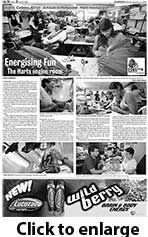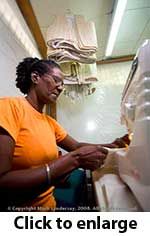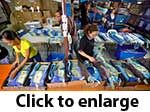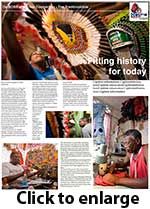Making 'Making Mas'
14/06/08 20:33 Filed in: How
Making " Making Mas"
Making Mas wasn't my idea. It was suggested to me by Anthony Wilson, currently the Acting Editor in Chief of the Guardian, but he saw the possibilities of a series on the creation of Carnival costumes modelled along the lines that I've been exploring in Trinidad and Tobago with Local Lives.
Local Lives has been on hiatus for a year while I worked on other projects that were, to be frank, less about art than commerce.
Since my return to full-time professional photography in 2006, I've been very clear about my own need to balance what people need with what I want to do and the best way to achieve that has been pursuing my own projects in the spaces between formal assignments.
With Local Lives on pause, I took up my La Fleur Morte project as a way of feeding my personal work Jones.
Making Mas is, basically, Local Lives but with a more circumscribed subject, a single page allotted to each instalment and a pretty brutal deadline.
 The project launched with its first instalment on January 11, 2008 in a Carnival season that would last just four weeks into the new year and costume construction proceeding apace.
The project launched with its first instalment on January 11, 2008 in a Carnival season that would last just four weeks into the new year and costume construction proceeding apace.
I was given a page on Monday and another on Friday for a total of seven instalments before Carnival Monday and Tuesday.
There were some aspects of the project that weren't completed. I badly miscalculated the construction schedule for Children's Carnival costumes and when I started calling, everyone was finished their work.
There were other aspects that were a challenge. This was, ultimately, a series about a single thing; people with their heads bent over working on costumes.
Making Mas isn't the first time that Carnival costumes have been photographed as they were being created, but over the years a lazy shorthand has evolved to describe the process.
There's the headpiece being fitted to the pretty masquerader shot, the acting like I'm doing something with a glue bottle/pliers/bit of wire shot and the bandleader pointing to the costume designs shot.
Some bandleaders or section managers told me right up front that they didn't have time to pose. They seemed pretty surprised when I told them that posing was the last thing I wanted.
 Getting around the predilection of people to perform for a camera is always a challenge, particularly in circumstances where a camera rarely gets poked. My usual method is to work quietly and continuously until everyone gets bored and gets back to what ever they need to be doing.
Getting around the predilection of people to perform for a camera is always a challenge, particularly in circumstances where a camera rarely gets poked. My usual method is to work quietly and continuously until everyone gets bored and gets back to what ever they need to be doing.
The cruel deadlines of Carnival 2008 were a big help with that. Clowning around for the photographer wasn't something that anyone in charge of production had a lot of patience with.
That left me with some technical challenges. People bent over working, again and again tends to get boring, so I employed lighting (Canon hotshoe flashes at arm's length or on lightweight stands in some circumstances) whenever existing light failed me to lift workers out of the realm of the humdrum and sought situations that brought character to the work.
I like my lighting to be invisible, so in many cases the strobe light is meant to either fill unreadable shadows or put light where you would expect to find it, now where it makes me look terribly clever.
Some photos were gifts. The photograph of Douglas John and his mother was true to the situation, but John offered to bring some backpacks and headpieces back upstairs to hang on the line (he had put them away a few hours before).
 Many were work. The photo of the Tribe packaging line required two wireless hotshoe flashes to light in circumstances so dim that even high ISO photos were murky and undistinguished. I then had to keep shooting until everyone got back into the rhythm of packing and set my presence perched on a ladder aside in their minds.
Many were work. The photo of the Tribe packaging line required two wireless hotshoe flashes to light in circumstances so dim that even high ISO photos were murky and undistinguished. I then had to keep shooting until everyone got back into the rhythm of packing and set my presence perched on a ladder aside in their minds.
Some situations were rich with opportunities; others were a mystery to be decoded. The Kalicharans work in a small space, no more than thirty feet square, leaving me in a box with few angles to explore.
As with Local Lives, I produced each instalment from beginning to end, from selecting the people to be featured, to conducting the interviews, writing the story and roughing out the layout.
If a Local Lives story is a short story, each Making Mas was a haiku.
Without a second page to extend the visual aspects of the story, I needed to ensure that the words didn't repeat the photos and vice versa.
The traditional rules of the photoessay were enforced with underlines. Some lovely photos that didn't offer enough information were set aside in favour of less dramatic images that knitted the story together more tightly. There's a tableau photo of Ancil McClean that I particularly like but it didn't read as well small as the one I finally chose.
 After the photography was done, I'd spend a day with a rough draft of the story and a rough layout of the page, juggling impact with information to tell the best story that was most likely to grab some attention on the printed page.
After the photography was done, I'd spend a day with a rough draft of the story and a rough layout of the page, juggling impact with information to tell the best story that was most likely to grab some attention on the printed page.
I delivered colour corrected and toned RGB files with NewsEdit copy and a PDF and print of the rough layout to the Guardian and let the designers do their work.
It was a tough project, with far too little time and too little space, but it was a remarkable opportunity to meet a wide range of mas producers working in Trinidad today.
What has been particularly striking about the experience is the hospitality and enthusiasm of my subjects.
In the afterglow of the project, I've found even more surprises in the reception that it has received on the web. In January 2008, my web visitors jumped by more than 1,000 for the month with key references coming from Trini bloggers focused on the Carnival space.
So in concluding, here's a hearty big-up to the folks who took kind note of the work.
Saucy Trini
Massassination
Keith in Trinidad
If you're interested in some of the off-camera strobe techniques I use, visit this website.
Return to Making Mas here.
Making Mas wasn't my idea. It was suggested to me by Anthony Wilson, currently the Acting Editor in Chief of the Guardian, but he saw the possibilities of a series on the creation of Carnival costumes modelled along the lines that I've been exploring in Trinidad and Tobago with Local Lives.
Local Lives has been on hiatus for a year while I worked on other projects that were, to be frank, less about art than commerce.
Since my return to full-time professional photography in 2006, I've been very clear about my own need to balance what people need with what I want to do and the best way to achieve that has been pursuing my own projects in the spaces between formal assignments.
With Local Lives on pause, I took up my La Fleur Morte project as a way of feeding my personal work Jones.
Making Mas is, basically, Local Lives but with a more circumscribed subject, a single page allotted to each instalment and a pretty brutal deadline.

I was given a page on Monday and another on Friday for a total of seven instalments before Carnival Monday and Tuesday.
There were some aspects of the project that weren't completed. I badly miscalculated the construction schedule for Children's Carnival costumes and when I started calling, everyone was finished their work.
There were other aspects that were a challenge. This was, ultimately, a series about a single thing; people with their heads bent over working on costumes.
Making Mas isn't the first time that Carnival costumes have been photographed as they were being created, but over the years a lazy shorthand has evolved to describe the process.
There's the headpiece being fitted to the pretty masquerader shot, the acting like I'm doing something with a glue bottle/pliers/bit of wire shot and the bandleader pointing to the costume designs shot.
Some bandleaders or section managers told me right up front that they didn't have time to pose. They seemed pretty surprised when I told them that posing was the last thing I wanted.

The cruel deadlines of Carnival 2008 were a big help with that. Clowning around for the photographer wasn't something that anyone in charge of production had a lot of patience with.
That left me with some technical challenges. People bent over working, again and again tends to get boring, so I employed lighting (Canon hotshoe flashes at arm's length or on lightweight stands in some circumstances) whenever existing light failed me to lift workers out of the realm of the humdrum and sought situations that brought character to the work.
I like my lighting to be invisible, so in many cases the strobe light is meant to either fill unreadable shadows or put light where you would expect to find it, now where it makes me look terribly clever.
Some photos were gifts. The photograph of Douglas John and his mother was true to the situation, but John offered to bring some backpacks and headpieces back upstairs to hang on the line (he had put them away a few hours before).

Some situations were rich with opportunities; others were a mystery to be decoded. The Kalicharans work in a small space, no more than thirty feet square, leaving me in a box with few angles to explore.
As with Local Lives, I produced each instalment from beginning to end, from selecting the people to be featured, to conducting the interviews, writing the story and roughing out the layout.
If a Local Lives story is a short story, each Making Mas was a haiku.
Without a second page to extend the visual aspects of the story, I needed to ensure that the words didn't repeat the photos and vice versa.
The traditional rules of the photoessay were enforced with underlines. Some lovely photos that didn't offer enough information were set aside in favour of less dramatic images that knitted the story together more tightly. There's a tableau photo of Ancil McClean that I particularly like but it didn't read as well small as the one I finally chose.

I delivered colour corrected and toned RGB files with NewsEdit copy and a PDF and print of the rough layout to the Guardian and let the designers do their work.
It was a tough project, with far too little time and too little space, but it was a remarkable opportunity to meet a wide range of mas producers working in Trinidad today.
What has been particularly striking about the experience is the hospitality and enthusiasm of my subjects.
In the afterglow of the project, I've found even more surprises in the reception that it has received on the web. In January 2008, my web visitors jumped by more than 1,000 for the month with key references coming from Trini bloggers focused on the Carnival space.
So in concluding, here's a hearty big-up to the folks who took kind note of the work.
Saucy Trini
Massassination
Keith in Trinidad
If you're interested in some of the off-camera strobe techniques I use, visit this website.
Return to Making Mas here.
blog comments powered by Disqus